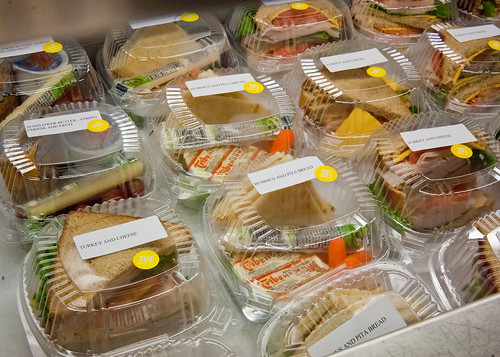
Hummus and Pita Bread, Sunflower butter string cheese and fruit, Turkey and cheese sandwiches prepared for the National School Lunch Program at Washington-Lee High School in Arlington, Virginia.
As many schools wind down for the year, USDA is gearing up for exciting new improvements designed to make the 2014-2015 school year even healthier for our nation’s future leaders. It’s a commitment rooted in the Healthy, Hunger-Free Kids Act of 2010. In that legislation, USDA is directed to update the school meals to reflect the latest Dietary Guidelines for Americans.
The new school meal requirements are intended to ensure children get the nutrition they need for academic performance and overall health. That’s a mission USDA takes seriously. Feeding kids, and feeding them well, can be a challenge. I understand that as a former school nutrition director, mother, and now grandmother. Plus, we know that change, in general, can be difficult. That is why we are working closely with schools to make sure the transition to the updated standards runs as smoothly as possible. We are listening to what school nutritional professionals, teachers, parents and students are telling us. These partners are the heart and soul of the school community and we have provided flexibilities based on their important feedback.
For instance, early in the implementation process, when schools asked for flexibility to serve larger servings of grains and proteins within the overall calorie caps, USDA responded by allowing that flexibility. In January of this year, that flexibility was made permanent. It’s worth pointing out that USDA sets general requirements for food amounts and food components (including grains), but local operators have the ultimate discretion on specific food items, recipes and products to offer their students.
Beginning July 1, 2014, federal regulations require that all grains offered in the National School Lunch Program and School Breakfast Program must be “whole grain-rich.” This doesn’t mean that only “100% whole grain” foods are allowed. It simply means that at least half of the grain in a food item must be whole grain. The remaining 50 percent or less of grains, if any, must be enriched.
We know that the progression to all whole grain-rich grains in school meals represents a significant transition for industry, program operators and students, especially when it comes to some popular products like pasta. The pasta industry has let us know that they are still working to develop some whole grain-rich products that have a reliable and acceptable taste and texture, while meeting commercial food service preparation and holding expectations. Because of this, we understand that during school years 2014-2015 and 2015-2016, some schools may still struggle to incorporate whole grain-rich pasta into their menu items. In response, USDA is offering schools continued flexibility to serve some enriched pastas. We will also continue to provide technical assistance to schools and industry as they strive to meet these requirements.
For additional information on whole grain-rich requirements, including how to evaluate if a grain product meets the whole grain-rich criteria, see the Whole Grain Resource for the National School Lunch and Breakfast Programs: A Guide to Meeting the Whole Grain-Rich Criteria, available at: http://www.fns.usda.gov/sites/default/files/WholeGrainResource.pdf.
Change can be tough, but it is worth it. I am proud to say that with the strong support of the community, our schools are making a real difference in the health of our nation’s children.
No comments:
Post a Comment